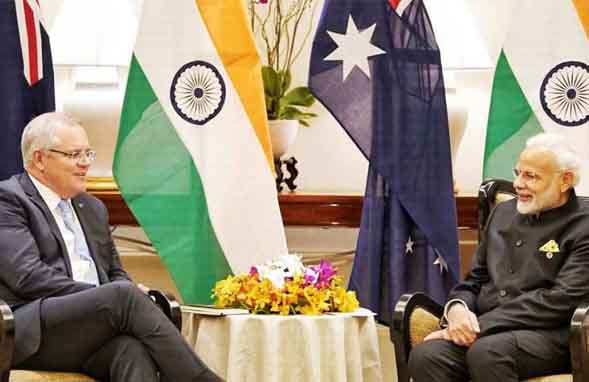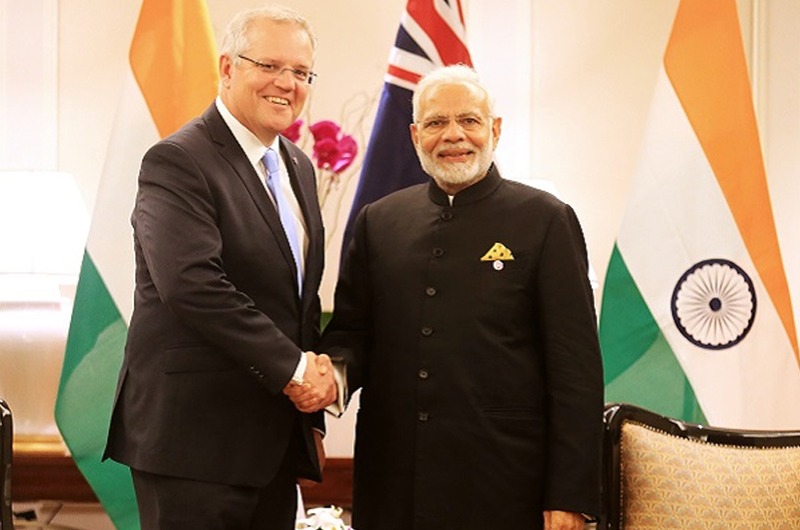
Dr Shubhamitra Das
Bilateral ties between India and Australia have evolved into a strong strategic partnership since the conception of the ‘Indo-Pacific’ Region. In spite of similar histories, political legacies, and ideologies on international law, these two countries had divergent foreign policies due to an ideational difference in understanding the contemporary world order.
The slowly evolving partnership between the two countries needs to be studied from two angles: a) From the wider context of the interplay of power between United States and China and how Australia and India will balance with their presence and partnership to bring a semblance in economic and security challenges, and b) Understanding the dynamism of the term Indo-Pacific; the trilateral and mini-lateral arrangements within the region, the proposed quadrilateral arrangement and the inevitability of collaboration by like-minded countries. The conception of Indo-Pacific is centred on energy security, sustainable economic growth, security and safety of the huge resources, wealth and technology travelling on the Indian and the Pacific Oceans, and aimed at ensuring freedom of navigation, freedom of air-sea-water spaces, settlement of disputes peacefully and respect for International Law. New Delhi and Canberra are keen to develop its strategic and economic presence in the Indian Ocean as partners and the strategy is slowly unfolding with the high level visits from both the countries and collaborating in myriad ways and signing of MOUs on issues that could enhance and sustain the partnership in the long-run.
President’s Visit to Australia
To make the strategic partnership much more enduring, trade relations and the Indian diaspora were highlighted by the first-ever Indian President’s visit to Australia in November 2018. President Ram Nath Kovind attended the unveiling ceremony of a statue of Mahatma Gandhi in Sydney and addressed a large number of Indian Diaspora. Paying respects at ANZAC War Memorial is a projection of cultural and historical bonding of the Indian people with Australia. President Kovind addressed Australian Financial Review Business’s Australia-India Business Council meet to boost the trade and business with Canberra. India elaborated on its ‘Economic Strategy to 2035 and India’s economic growth in technology and logistics, industrial design and biotech, capital markets and agri-business’ where India and Australia find immense potential to cooperate. Australia’s investment is likely to increase in areas of crucial importance to both the countries which is at AUD 10 billion in 2018.
The earlier Prime Ministers of Australia termed India to be a ‘natural’ partner and the present Prime Minster Scott Morison said India is a ‘critical’ partner and had deepened the bilateral trajectory leading to the signing of MOUs on such diverse issues that not only strengthened the relation but has broadened the levels of interaction from ministerial level to people-to-people contacts. India signed MOUs with Australia in strengthening institutional partnership in the field of education, health and medicine, sharing of knowledge and technology, mining, textiles and fashion, sports and tourism. Some MOUs were signed to understand the economic policy and growth patterns of the two countries and find opportunities for further collaboration. The Australia-India Strategic Research Fund (AISRF) is a flagship programme signed by both the countries to solve problems and share knowledge on ‘energy storage, marine science and plant genomics.’ With agricultural sector becoming more and more vulnerable due to poor governance and climate change and the introduction of sophisticated technology like precision farming and biotechnology, the collaboration was timely and productive. The President’s visit has made it clear that India will be more constructive in taking the relation further than the uranium deal.
Energy Deal
India and Australia have strong ties in the energy sector: like in solar and wind energy, natural gas and geothermal energy apart from coal and uranium. India is dramatically increasing its renewable energy resources, especially of wind and solar energy through its ‘clean energy’ policy, and is depending less on coal. Nuclear Deal signed by both the countries in 2014 is a landmark achievement in this bilateral partnership. It is not the culmination of strategic partnership but a convergence of economic, defence, diplomatic and cultural issues that forms the outer circle of the core cooperation structure. Australian Defence White Paper 2009 mentioned that “As India extends its reach and influence into areas of shared strategic interests, we need to strengthen our defence cooperation and understand India’s strategic thinking” and in 2009 itself India and Australia agreed on a Joint Declaration on Security Cooperation. Australian government has announced to spend $14 billion to provide 7000 megawatts of clean electricity to India by shipping uranium. The debate goes on as to how many nuclear plants India can build, how much uranium will be given to India and can India bear the cost of it all; amidst the local agitations of the safety levels of nuclear plants and its hazardous wastes costing human life. Though civil nuclear deal between the countries is the starting point of their strategic relationship; its impact would be rather less compared than naval exercises, sharing of technology and logistics.
India-Australia Strategic Partnership
The bilateral relation between India and Australia is most vibrant in the field of defence and security with a tilt towards maritime security. The strategic and economic challenges in the Indo-Pacific region were addressed by India and Australia at the multilateral organisations like EAS and Indian Ocean Regional Association (IORA); where Indian Ocean Naval Symposium (IONS) was preferred to be within the maritime operations of IORA. The bilateral naval exercises like AUSINDEX, Pitch Black, Kakadu naval exercise, Black Clarion Submarine Rescue Exercise were to ensure interoperability and in sharing and solving maritime security issues. The naval exercises on anti-submarine warfare, on surveillance/ monitoring/regular patrolling have increased India’s outreach levels as far as Pacific Island Countries and had also helped in the reduction of piracy on the Indian Ocean. An MOU was signed in May 2017 in Combating International Terrorism and Transnational Organised Crime which will ensure collaboration and sharing of knowledge for a peaceful region and act further in the field of humanitarian aid, Peace Corps and in disaster management and mitigation in the region. The crux of the strategic partnership is to find a level playing field being at the gateway to Indo-Pacific region.
The Strategic requirements made Australia support India to join certain key multilateral organisations like Asia-Pacific Economic Cooperation (APEC), United Nations Security Council (UNSC), Nuclear Supplier Group (NSG), Missile Technology Control Regime (MTCR), the Australia Group and the Wassenaar Arrangement (WA) (where India joined in December, 2017). Both participate and simultaneously support each other in Regional Comprehensive Economic Partnership, East Asia Summit, ASEAN Regional Forum, ASEAN Defence Ministerial Meeting plus. Both the countries have brought their bilateral partnership to a regional level, thus enhancing the global multilateral structures. The recent developments show that there is a convergence of interests to keep the region safe and stable.
Contrarily both the countries are apprehensive to extend their cooperation; like the Malabar exercise in which India, United States and Japan participates – Australia was invited to make the much debated Quadrilateral arrangement institutionalised. Both the times Australia could not join because China was not to be offended. Australia’s perpetual dilemma over balancing between the US alliance and economic dependence on China and India’s political equations in the region vis-à-vis China-Pakistan closeness has effected deeper engagement between India and Australia. The apprehension is felt in the way both the countries perceive the Quadrilateral arrangement between India, United States, Japan and Australia. Meanwhile the trilateral arrangement between ‘India, Japan and the United States’ and ‘Australia, Japan and the United States’ is working rather well. This shows that India and Australia are slowly but cautiously moving towards a strategic bilateral partnership.
Conclusion
India and Australia had waited for too long to take their relation to the next level. China’s expansionism has reinterpreted regional order. China’s One Belt One Road (OBOR), if it materialises, will have serious consequences both strategically and economically. While stability, regionalism, increased use of clean energy and inter-state development were the drivers of the strategic bilateral partnership, the underlying notion of maintaining the ‘Rules Based International Order’ and ‘Free and Open’ Indo-Pacific forms the bedrock of strategic equations. India-Australia bilateralism will take some time before it can influence regional dynamics.










